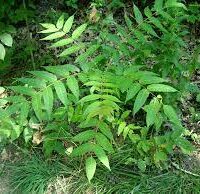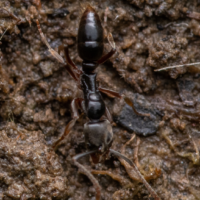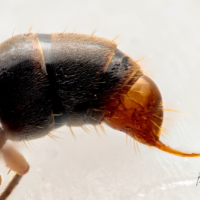 Purdue University - Extension - Forestry and Natural Resources
Purdue University - Extension - Forestry and Natural Resources
Got Nature? Blog
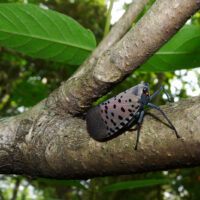 Spotted lanternfly is a major pest of concern across most of the United States. Spotted lanternfly (SLF) is an invasive planthopper native to China that was first detected in the United States in Pennsylvania in 2014. SLF feeds on over 70+ plant species including fruit, ornamental and woody trees with tree-of-heaven as its preferred host. Spotted lanternfly is a hitchhiker and can easily be moved long distances through human assisted movement.
Spotted lanternfly is a major pest of concern across most of the United States. Spotted lanternfly (SLF) is an invasive planthopper native to China that was first detected in the United States in Pennsylvania in 2014. SLF feeds on over 70+ plant species including fruit, ornamental and woody trees with tree-of-heaven as its preferred host. Spotted lanternfly is a hitchhiker and can easily be moved long distances through human assisted movement.
Tree of heaven (TOH) is the preferred host for the spotted lanternfly (SLF). The ability to identify TOH will be critical to monitoring the spread of this invasive pest as the 4th-stage nymphs and adult spotted lantern-flies show a strong preference for TOH.
Report a Sighting
- Take a picture and note your location.
- If you can, collect a sample of the insect by catching it and placing it in a freezer. You can use any container available as long as it has a tight seal (like a water bottle) so that the spotted lanternfly can’t escape.
- Report the sighting at DEPP@dnr.in.gov, eddmaps.org, or 1-866-663-9684.
- Check your car and outdoor equipment for spotted lanternfly eggs, nymphs, and adults before driving or moving to a new location.
- Don’t move firewood because it can spread spotted lanternfly and many other invasive insects.
- Stay up to date with the latest spotted lanternfly information by subscribing to our newsletters (www.purduelandscapereport.org/ and www.in.gov/dnr/entomology/entomology-weekly- review/) and following us on Facebook, Twitter, and Instagram (@reportINvasive and @INdnrinvasive).
- Share your spotted lanternfly knowledge with others!
Resources:
Spotted Lanternfly, Indiana Department of Natural Resources Entomology
Spotted Lanternfly Found in Indiana, Purdue Landscape Report
Invasive plants: impact on environment and people, The Education Store, Purdue Extension’s resource center
Woodland Management Moment: Invasive Species Control Process, Video, Purdue Extension – Forestry and Natural Resources YouTube Channel
Invasive Species, Playlist, Purdue Extension – FNR YouTube Channel
What are invasive species and why should I care?, Got Nature? Blog, Purdue Extension – Forestry and Natural Resources
Report Invasive
Diana Evans, Extension and Web Communication Specialist
Purdue University Department of Forestry and Natural Resources
It is official. The Asian needle ant is our newest invasive insect pest and has now become a permanent resident, stinging ant. Two ant specimens taken from a wooded area in southern Indiana by an astute amateur entomologist, who observed their appearance and behavior as ‘out of the ordinary’, was submitted to the Indiana Department of Natural Resources and to the Purdue University Plant and Pest Diagnostic Laboratory for species identification in February, 2022. Both were confirmed to be Formicidae: Brachyponera chinensis, commonly known as the Asian needle ant, not previously recorded from Indiana.
Asian needle ants (ANAs), originally from Eastern Asia (China, Japan, and Korea), were first discovered in the United States in the early 1930s, but only recognized as a pest since 2006. They have been officially established in several states in the U.S. including North Carolina, South Carolina, Alabama and Georgia and, have been anecdotally reported as far north and west as New York, Tennessee and Kentucky.
Note that stings to humans will be moderately painful (potentially causing severe allergic reactions to susceptible individuals) much like fire ant or bee stings, but fortunately because these ants are much less aggressive in protecting their nests, the number of stings per encounter will be less.
The First Report of the Invasive Asian Needle Ant in Indiana pdf provides more details on their identification and biology.
If you want to confirm a sighting of the Asian needle ant please contact the Purdue University Plant and Pest Diagnostic Laboratory at this time. More information will be presented as experts monitor the spread.
Resources:
Thousand Cankers Disease, collaborative website
Thousand Cankers Disease, Indiana Department of Natural Resources
Thousand Cankers Disease: Indiana Walnut Trees Threatened, The Education Store, Purdue Extension’s resource center
Indiana Walnut Council
Spotted lanternfly: Everything You Need to Know in 30 Minutes, Video, Emerald Ash Borer University
Emerald Ash Borer, EAB Information Network
Report Invasive Species, Purdue Invasive Species
The GLEDN Phone App – Great Lakes Early Detection Network
EDDMaps – Early Detection and Distribution Mapping System
Indiana Department of Natural Resources: Invasive Species
Indiana Invasive Species Council
Cooperative Invasive Species Management Area (CISMA)
Invasive plants: impact on environment and people, The Education Store
Woodland Management Moment: Invasive Species Control Process, Video, Purdue Extension – Forestry and Natural Resources (FNR) YouTube Channel
Invasive Species, Playlist, Purdue Extension – FNR YouTube Channel
What are invasive species and why should I care?, Got Nature? Blog, Purdue Extension – Forestry and Natural Resources
Report Invasive
Indiana Department of Entomology and Plant Pathology
Tim Gibb, Insect Diagnostician and Extension Specialist
Purdue Department of Entomology
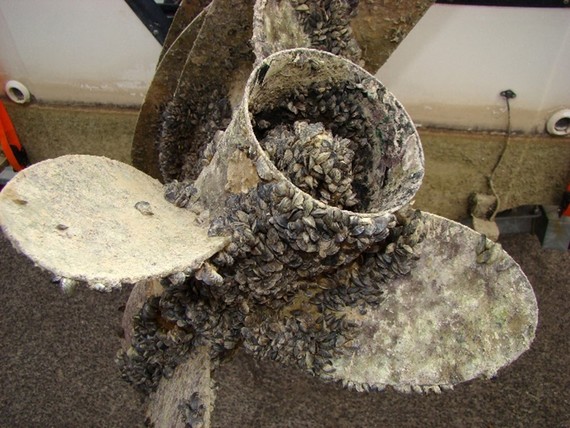 Wild Bulletin, Indiana Department of Natural Resources: As you prepare your boat or recreational equipment to get back on the water this spring, remember to look for aquatic hitchhikers. Zebra mussels, aquatic plants like Eurasian watermilfoil or starry stonewort, and many other invasive species continue to be a threat to Indiana’s waters by degrading fish habitat and negatively affecting recreational boating and fishing. The most common locations where plants, mussels, and animals hitch a ride include:
Wild Bulletin, Indiana Department of Natural Resources: As you prepare your boat or recreational equipment to get back on the water this spring, remember to look for aquatic hitchhikers. Zebra mussels, aquatic plants like Eurasian watermilfoil or starry stonewort, and many other invasive species continue to be a threat to Indiana’s waters by degrading fish habitat and negatively affecting recreational boating and fishing. The most common locations where plants, mussels, and animals hitch a ride include:
- Transom well near the drain plug
- Axle of the trailer
- Lower unit and propeller on the boat motor
- The rollers and bunks that guide the boat onto the trailer
- Anchor and lines
- Bait bucket and live well
Boat owners are asked to drain water from bait buckets, live wells, and boats before leaving the boat landing; leave drain plugs out while travelling on land; clean and dry anything that came in contact with water; and dispose of unwanted bait in the trash. Learn more about aquatic invasive species and how to prevent their movement.
Learn how to stop aquatic hitchhikers.
Find more information about aquatic invasive plants and aquatic invasive invertebrates. Subscribe and receive the Wild Bulletin, Indiana Department of Natural Resources.
Resources:
Invasive plants: Impact on Environment and People, Purdue Extension – Forestry and Natural Resources (FNR)
Report Invasive Species, Purdue Invasive Species
The GLEDN Phone App – Great Lakes Early Detection Network
EDDMaps – Early Detection and Distribution Mapping System
Indiana Department of Natural Resources: Invasive Species
Indiana Invasive Species Council
Cooperative Invasive Species Management Area (CISMA)
Aquatic Invasive Species in the Great Lakes: The Quagga Mussel, Purdue Extension – FNR
Lampreys, Indiana Division of Fish and Wildlife’s Animal Informational Series
Aquatic Invaders in the Marketplace, Illinois-Indiana Sea Grant (IISG)
Great Lakes Sea Grant Network (GLERL), NOAA – Great Lakes Environmental Research Laboratory
Purdue Researchers Get to the Bottom of Another Quagga Mussel Impact, Illinois-Indiana Sea Grant (IISG)
Protect Your Waters, U.S. Fish and Wildlife Service & U.S. Coast Guard
Nongame and Endangered Wildlife, Indiana Department of Natural Resources
Indiana Department of Natural Resources
Purdue Forestry and Natural Resources’ extension efforts over the past two years amidst the COVID-19 pandemic were recognized in the Purdue Extension Specialist Quarterly newsletter.
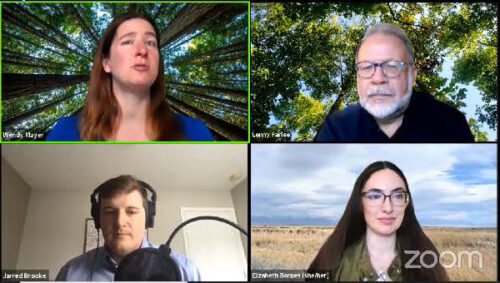 The transition to virtual content brought expertise across subject matter areas, ranging from forestry and wildlife, to aquatic sciences and entomology, to the masses in the form of several video series which collectively earned nearly 150,000 views.
The transition to virtual content brought expertise across subject matter areas, ranging from forestry and wildlife, to aquatic sciences and entomology, to the masses in the form of several video series which collectively earned nearly 150,000 views.
The FNR Extension team included: Jay Beugly, Jarred Brooke, Nick Burgmeier, Barny Dunning, Diana Evans, Lenny Farlee, Jason Hoverman, Liz Jackson, Brian MacGowan, Patrick McGovern, Wendy Mayer, Charlotte Owings, Lindsey Purcell, Bee Redfield, Shelby Royal, Bob Rode, Kara Salazar, Mike Saunders, Amy Shambach, Rod Williams, Mitch Zischke, as well as frequent Entomology contributors: Elizabeth Barnes, Cliff Sadof.
The feature in the fourth quarter newsletter begins:
“While Covid caused limitations on travel and in-person events nationwide, across Indiana, many were spending more time in outdoor recreational activities, hiking, bird-watching, hunting and fishing, or managing natural resources properties. Adjusting to the pandemic, the FNR team created an innovative and team-oriented instruction approach through skill-building in video production with coordinated connection and crosspromotion of resources.
“Forestry and Natural Resources (FNR) faculty, specialists, staff, and students, with invited partners across research and Extension, delivered 45-minute Ask an Expert Facebook Live programs for 35 weeks. Programs covered many FNR specialties: Animals & Insects (bats, bird, cicadas, coyotes, deer, fish, frogs, hellbenders, moles, pollinators, salamanders, snakes, toads, turtles, and wood pests); Plants & Ecosystems (invasive plant species, hardwood ecosystems, native grasses for wildlife, conservation tree planting, rainscaping, fall food plots, and selecting, planting and inspecting trees); and Management & Operations (prescribed fires, aquatic plant and pond management, and fish and wildlife management).
Resources:
Ask An Expert Playlist, Purdue Extension – Forestry and Natural Resources (FNR) YouTube Channel
ID That Tree Playlist, Purdue Extension – FNR YouTube Channel
A Woodland Management Moment Playlist, Purdue Extension – FNR YouTube Channel
Wildlife Habitat Hint Playlist, Purdue Extension – FNR YouTube Channel
Subscribe to the Purdue Extension – Forestry and Natural Resources YouTube Channel
Wendy Mayer, FNR Communications Coordinator
Purdue University Department of Forestry and Natural Resources
Diana Evans, Extension and Web Communication Specialist
Purdue University Department of Forestry and Natural Resources
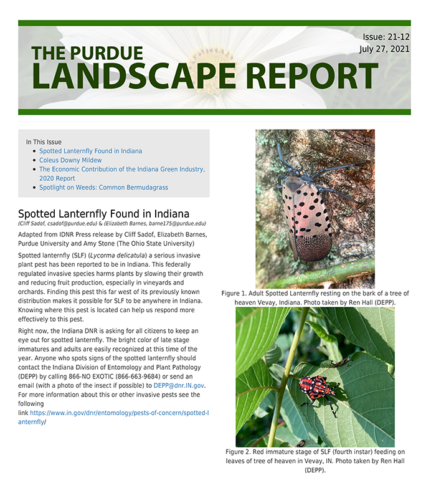 The interdisciplinary faculty and staff behind the Purdue Landscape Report, which provides science-based, timely information regarding Midwest landscapes to commercial growers, garden centers, landscapers, arborists and the general public, has been named as the recipient of the Purdue Agriculture TEAM Award, which was created in 1995 to recognize interdisciplinary team achievements of faculty and staff.
The interdisciplinary faculty and staff behind the Purdue Landscape Report, which provides science-based, timely information regarding Midwest landscapes to commercial growers, garden centers, landscapers, arborists and the general public, has been named as the recipient of the Purdue Agriculture TEAM Award, which was created in 1995 to recognize interdisciplinary team achievements of faculty and staff.Led by Kyle Daniel, nursery and landscape outreach specialist in the Department of Horticulture and Landscape Architecture, the Purdue Landscape Report is a collaborative effort between Purdue Extension specialists and diagnosticians in the departments of Botany and Plant Pathology, Entomology, Forestry and Natural Resources, and Horticulture and Landscape Architecture. Articles cover everything from urban forestry and tree maintenance to pest and disease problems and management to plant selection and turf science. In addition to an email newsletter and online blog, PLR staff also provide live interactive webinars in order to highlight content and respond to questions from the audience.
In response to the pandemic, the Purdue Landscape Report staff also began a live, to addresses articles and hot topics. That series garnered more than 2,000 views.
In a January 2021 survey sent to PLR subscribers, 88% of respondents said they believed that the newsletter improved their ability to diagnose a problem, while 76% said that PLR has had a positive economic impact on their business.
A local professional shared that “Sometimes when I open up the PLR, it is like you have been reading my mind. The problem I have been seeing or thinking about is there in your headlines.”
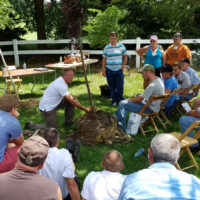 One PLR subscriber said “The Purdue Landscape Report is a great resource for myself and my team members. Within each issue is one or more topics that our team has encountered or discussed recently and the information provided by a very reputable source gives us the material needed to provide the best service to our clients and increase our knowledge base. The virtual sessions are another great resource provided that give an opportunity to have specific questions answered by experts.”
One PLR subscriber said “The Purdue Landscape Report is a great resource for myself and my team members. Within each issue is one or more topics that our team has encountered or discussed recently and the information provided by a very reputable source gives us the material needed to provide the best service to our clients and increase our knowledge base. The virtual sessions are another great resource provided that give an opportunity to have specific questions answered by experts.”
The impact extends from landowners to industry professionals and beyond.
“Often we take for granted the information produced in the PLR and we forget the countless dollars we have saved from information in the PLR,” said Rick Haggard, Indiana Nursery and Landscape Association Executive Director.
“The Purdue Landscape Report provides timely information to the Indiana Arborist Association members and associated parties in a format that is easily accessed and understood,” Associate Executive Director of IAA Ashley Mulis said. “The collaboration that goes into providing this product demonstrates the cohesive nature of several departments within Purdue University and the open sharing and comparison of information. The Purdue Landscape Report is an excellent addition to the many publications offered within Purdue Extension in helping resource professionals manage the ever-changing landscape of pests, diseases and best management practices.”
Resources:
Purdue University Department of Forestry and Natural Resources
Indiana Arborist Association
The Purdue Landscape Report, a blog which provides science-based, timely information regarding Midwest landscapes to commercial growers, garden centers, landscapers, arborists and the general public, was recognized with the Extension Division Education Materials Award for Outstanding Blog at the American Society of Horticultural Science convention in August.
The Purdue Landscape Report is a collaborative effort between Purdue Extension specialists and diagnosticians in the areas of horticulture, entomology, plant pathology, urban forestry and turf science. Articles cover everything from tree maintenance to pest and disease problems and management to plant selection.
“Our Purdue Green Industry Team brings together many disciplines and expertise for the industry and homeowners as well as any other university in the country,” Nursey and Landscape Outreach Specialist Kyle Daniel said. “The research and outreach efforts of each member of the team contributes to helping the industry be more sustainable, efficient, environmentally conscious, and profitable. The Purdue Landscape Report is one way that we present science-based information to our stakeholders around the state. In addition to this information being distributed locally, there are many subscribers from across the country.”
The PLR team includes:
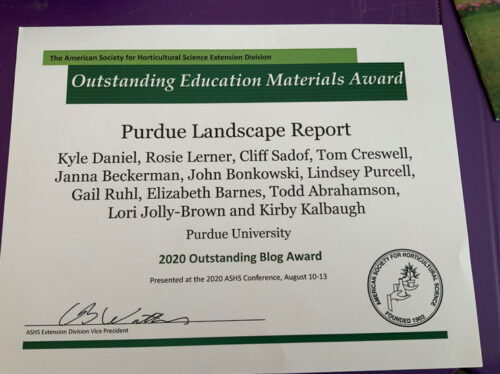 Kyle Daniel – Nursey and Landscape Outreach Specialist, Purdue Horticulture and Landscape Architecture
Kyle Daniel – Nursey and Landscape Outreach Specialist, Purdue Horticulture and Landscape Architecture- Rosie Lerner – Extension Consumer Horticulturist, Purdue Horticulture and Landscape Architecture
- Cliff Sadof – Professor, Entomology Extension Specialist
- Tom Creswell – Clinical Engagement Professor, Director of the Plant & Pest Diagnostic Laboratory; Purdue Botany and Plant Pathology
- Janna Beckerman – Professor of Botany and Plant Pathology
- John Bonkowski – Clerk, Purdue Botany and Plant Pathology
- Lindsey Purcell – Purdue Extension urban forester, Purdue Forestry and Natural Resources
- Gail Ruhl – Visiting Scholar, Purdue Biological Sciences
- Elizabeth Barnes – Exotic Forest Pest Educator, Purdue Entomology
- Todd Abrahamson – Purdue Plant & Pest Diagnostic Lab Secretary
- Lori Jolly-Brown – Extension Events and Communications Coordinator, Purdue Horticulture and Landscape Architecture
- Kirby Kalbaugh – Application and Systems Administrator, Purdue Horticulture and Landscape Architecture
Since launching in February 2018, the Purdue Landscape Report has included more than 144 articles. The website boasted more than 75,000 unique article downloads in 2019. PLR is also sent out in a bi-weekly email newsletter to more than 4,000 subscribers nationwide. The blog has brought in 137,000 unique visitors thus far in 2020.
In August, the Purdue Landscape Report staff also began a live, virtual series every other Wednesday, which addresses articles and hot topics. In just two months, that series has had more than 1,100 views.
Resources
Purdue Landscape Report Team Begins New Virtual Series, Got Nature? Blog, Purdue Extension – Forestry and Natural Resources
The Purdue Landscape Report Issues, Purdue Landscape Report
Tree wounds and healing, Got Nature? Blog
Fall webworms: Should you manage them, Got Nature? Blog
Purdue Landscape Report Facebook Page
 The Nature of Teaching, a Purdue Extension signature program, was honored as the third place finisher in the central region for the Environmental Education Award presented by the National Extension Association of Family and Consumer Science (NEAFCS).
The Nature of Teaching, a Purdue Extension signature program, was honored as the third place finisher in the central region for the Environmental Education Award presented by the National Extension Association of Family and Consumer Science (NEAFCS).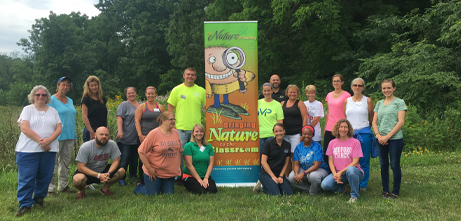 The Nature of Teaching team includes:
The Nature of Teaching team includes:
- Deb Arseneau, HHS Educator, Newton County
- Jarred Brooke, extension wildlife specialist
- Jay Christiansen, health and human sciences extension educator for Vigo County
- Robert Cordes, Maine Department of Inland Fisheries and Wildlife (MDIFW) wildlife special projects coordinator
- Molly Hoag, health and human sciences extension educator for Wells County
- Molly Hunt, health and human sciences extension educator for Delaware County
- Rebecca Koetz, urban ag/home horticulture extension educator for Lake County
- Tami Mosier, 4-H youth development extension educator
- Kelsie Muller, health and human sciences extension educator for Benton County
- Dr. Rod Williams, professor of wildlife science
- Brad Zitscke, Maine Department of Inland Fisheries and Wildlife (MDIFW) assistant regional wildlife biologist
Nature of Teaching
Nature of Teaching YouTube Channel
Transporting Food Waste, The Education Store, Purdue Extension resource center
Resourceful Animal Relationships, The Education Store
Benefits of Connecting with Nature, The Education Store
Join Purdue Extension urban forester Lindsey Purcell, exotic forest pest educator Elizabeth Barnes and entomology extension specialist Cliff Sadof as they share about how to inspect trees, what to look for, who to contact, etc., as well what invasive pests and diseases you should keep your eye out for.
If you have any questions regarding trees, forests, wildlife, wood products or other natural resource topics, feel free to contact us by using our Ask an Expert web page.
Resources
Ask an Expert, Playlist, Purdue Extension – Forestry and Natural Resources Youtube Channel
Tree Risk Management, The Education Store, Purdue Extension resource center
Tree Appraisal and the Value of Trees, The Educational Store
Surface Root Syndrome, The Education Store
Iron Chlorosis of Trees and Shrubs, The Education Store
Facebook Live – Ask The Expert: Pests in Your Woods, Got Nature? Blog, Purdue Extension – Forestry and Natural Resources
Fall webworms: Should you manage them, Got Nature? Blog
How to Identify Tree Defects and What to Do about It?, Got Nature? Blog
Lindsey Purcell, Urban Forestry Specialist
Purdue University, Department of Forestry and Natural Resources
Elizabeth Barnes, Exotic Forest Pest Educator
Purdue University, Department of Entomology
Cliff Sadof, Professor / Ornamental / Pest Management / Coordinator of Extension
Purdue University, Department of Entomology
Do you know what’s “bugging” your trees? There are several exotic insects which may be attacking our trees that you should be on the lookout for. Some have already arrived in Indiana, and others are still beyond our borders but have a risk of showing up here in the future.
Dr. Elizabeth Barnes, exotic forest pest educator with Purdue Department of Entomology, and Liz Jackson Purdue extension forestry specialist, describe these exotic insects, symptoms to watch for in your trees, and discuss what some of the biggest future pest concerns are in this Facebook Live session from June 18, 2020.
Resources
Purdue Report Invasive website
Indiana Department of Natural Resources Division of Entomology & Plant Pathology
Don’t Move Firewood
Purdue Plant and Pest Diagnostic Lab
Indiana District Foresters
Indiana Consulting Foresters
Purdue Landscape Report
Insect specific sites:
Thousand Cankers Disease (black walnut)
Asian Longhorned Beetle Information (from APHIS)
Spotted Lanternfly (Penn State Extension)
Emerald Ash Borer Information from Purdue
EAB University: Invasive insects and pathogens webinar series
Elizabeth Jackson, Manager Walnut Council/IN Forestry Woodland Owners Association (IFWOA) & Engage Specialist
Purdue University Department of Forestry and Natural Resources
Elizabeth Barnes, Exotic Forest Pest Educator
Purdue University Entomology
Purdue Forestry & Natural Resources extension specialists gathered for a Facebook LIVE event held May 5th to answer questions on a wide range of topics from woodland management to wildlife habitat, ponds to invasive species and more.
Topics ranged from what to do about moles, voles and Canada geese causing damage in your yard, to how to pick the right tree for your landscape and how to measure the worth of your trees. The presentation also included segments on what to do about algae in your pond to how to know if you need to restock it as well as what to do about invasive plant species and how to protect your trees from deer damage.
Get advice from extension specialists Jarred Brooke, Lenny Farlee, Brian MacGowan, Lindsey Purcell, Rod Williams and Mitch Zischke in the video below.
If you have any further questions feel free to send your questions by submitting our Ask An Expert form.
Resources mentioned:
Purdue Extension – The Education Store
Purdue Report Invasive Species Website
Midwest Invasive Species Network Database
TreesAreGood.org
Find a Forester in Indiana
Improve My Property for Wildlife, Purdue Extension
Online Mole Program, Event May 14th, Purdue FNR Extension
Have you seen a hairless squirrel, Got Nature? Blog, Purdue FNR Extension
Stocking Fish, The Education Store, Purdue Extension Resource Center
Tree Selection for the “Un-natural” Environment, The Education Store
Selecting a Nuisance Control Operator, The Education Store
Forest Products Price Report (pdf), Indiana Department of Natural Resources (IDNR)
Indiana DNR Nuisance Goose Control Options (pdf), Indiana Department of Natural Resources (IDNR)
Turtles of Indiana, The Education Store
Salamanders of Indiana, The Education Store
Frogs and Toads of Indiana, The Education Store
Snakes and Lizards of Indiana, The Education Store
Aquatic Plant Management, The Education Store
Native Grasses, The Education Store
Preventing Deer Browsing on Trees/Shrubs, Video, Purdue Extension Youtube Channel
Brian MacGowan, Wildlife Extension Specialist
Purdue University, Department of Forestry and Natural Resources
Recent Posts
- Spongy Moth in Spring Time – Purdue Landscape Report
Posted: June 3, 2024 in Alert, Forestry, Forests and Street Trees, How To, Invasive Insects, Urban Forestry - Report Spotted Lanternfly – Purdue Landscape Report
Posted: April 10, 2024 in Alert, Forestry, Invasive Insects, Plants, Wildlife, Woodlands - State of Indiana Proclamation-Invasive Species Week 2024
Posted: February 19, 2024 in Alert, Forestry, Forests and Street Trees, Invasive Animal Species, Invasive Insects, Invasive Plant Species, Urban Forestry, Wildlife, Woodlands - New Invasive Predator of Honeybees-Purdue Landscape Report
Posted: August 27, 2023 in Alert, How To, Invasive Insects, Wildlife - Should Ash Trees Still be Protected From Emerald Ash Borer?
Posted: May 12, 2023 in Forests and Street Trees, Invasive Insects, Urban Forestry - Report if You See a Spotted Lanterfly – MyDNR
Posted: May 10, 2023 in Alert, Forestry, Forests and Street Trees, Invasive Insects, Urban Forestry, Wildlife - Asian jumping worms: Where to get started – Landscape Report
Posted: April 27, 2023 in Invasive Insects, Nature of Teaching, Wildlife, Woodlands - Gardeners Asked to be Vigilant This Spring for Invasive Jumping Worm
Posted: March 17, 2023 in Forestry, How To, Invasive Insects, Plants, Wildlife - ID That Tree: Invasive Tree of Heaven
Posted: February 23, 2023 in Forestry, Forests and Street Trees, Invasive Insects, Invasive Plant Species, Plants, Urban Forestry, Woodlands - Why are the Japanese beetles running late this year?
Posted: July 20, 2022 in Forests and Street Trees, Gardening, How To, Invasive Insects, Urban Forestry, Wildlife
Archives
Categories
- Alert
- Aquaculture/Fish
- Aquatic/Aquaculture Resources
- Ask the Expert
- Christmas Trees
- Community Development
- Disease
- Drought
- Forestry
- Forests and Street Trees
- Gardening
- Got Nature for Kids
- Great Lakes
- How To
- Invasive Animal Species
- Invasive Insects
- Invasive Plant Species
- Land Use
- Natural Resource Planning
- Nature of Teaching
- Plants
- Podcasts
- Ponds
- Publication
- Safety
- Spiders
- Timber Marketing
- Uncategorized
- Urban Forestry
- Webinar
- Wildlife
- Wood Products/Manufacturing
- Woodland Management Moment
- Woodlands
